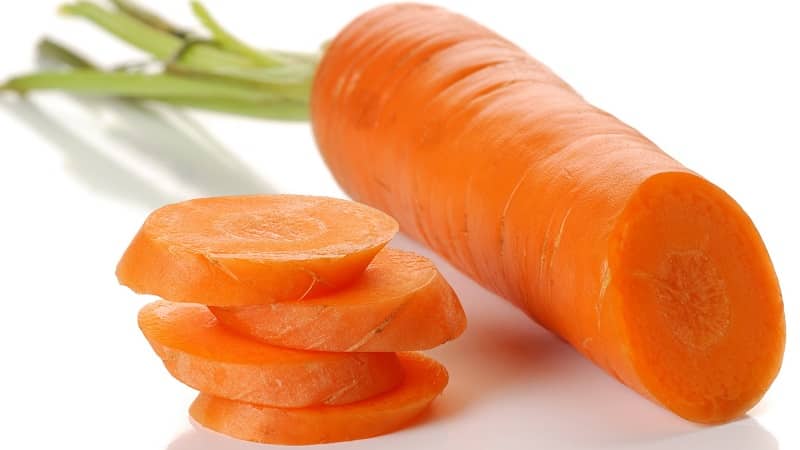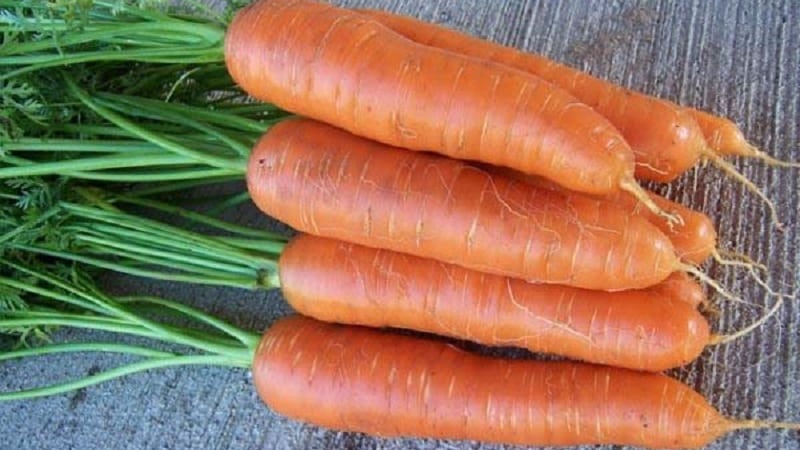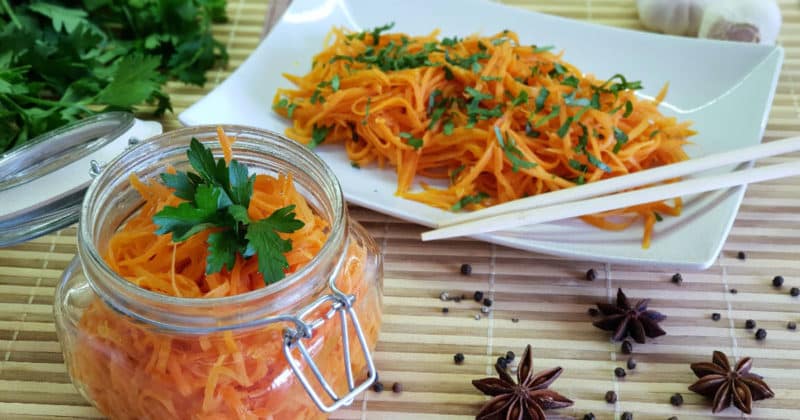How long can you store carrots in Korean?
Korean-style carrots are a unique dish, because all Russians love it, but Koreans themselves have never even heard of it. Carrots, grated or cut into long strips and seasoned with hot spices, are appropriate on the table not only on ordinary days, but also on holidays. It is important to consume this dish exclusively fresh so as not to harm the digestive system. You will learn about the terms and conditions for storing carrots in Korean from this article.
How to choose the right carrots for salad

Besides size and shape, carrots vary greatly in color. The bright orange hue of the root vegetable appears due to its high beta-carotene content. The less of this substance in carrots, the paler it is. There are also varieties that have brightyellow, purple and white colors.
The taste of carrots depends partly on the color. The juiciest varieties are orange. In pale ones, the taste qualities are less pronounced. Purple varieties have their own taste and other characteristics. They are used to prepare spicy dishes.
The rarest varieties of carrots have pink and red root vegetables. But they are very difficult to find in Russian markets. Even when such carrots are brought in and put on the counter, they are poorly sold. People think that these root vegetables were grown using a lot of chemicals and dyes. In fact, the color depends on the ratio of substances in carrots.
When choosing vegetables for cooking carrots in Korean, pay attention to the quality and degree of ripeness. Color in this case plays a secondary role. But when buying exotic varieties, it is important to find out in advance what they should look like in order to buy a quality product.
Pay attention to the following:
- Brightness. The brighter the carrots, the more nutrients they contain. In the case of other vegetables and fruits, a rich color is considered a sign of the presence of a large amount of nitrates.
- The surface must be smooth, without cracks, damage or other deformations.
- Be sure to choose only hard vegetables. If the root crop is soft, this indicates that it has begun to deteriorate.
- The area near the tops should be a rich green color.
- If the vegetables will only be processed in a few days, buy unwashed carrots.
Do not buy root vegetables if the following signs are noticeable:
- Severe deformation or visible damage. This affects the taste characteristics.
- Small dots or dark spots. They indicate that the process of rotting has begun in the vegetable.
- Green spots. This indicates that the carrots are unripe or have been stored in the sun for a long time. In this case, the finished dish will be bitter.
- The middle of the root vegetable strongly contrasts in color with the part located closer to the skin. This means that the carrots were grown using a lot of chemicals.
- Vegetables with shoots. They have less pronounced taste qualities because they are overripe. Also, growths sometimes indicate the presence of diseases in carrots or the presence of nitrates.
- Soft surface of the root crop. This suggests that the process of rotting is probably already underway inside.
- Fruits with many cracks. They often turn out to be spoiled inside.
- Light carrots. For a long time it was considered a fodder.Now there are special varieties of light color, but still, when purchasing, they give preference to a rich and bright color.
- Vegetables whose surfaces are moist or greasy to the touch. The root crop is either spoiled or treated with chemicals.
- Root vegetables with black thin stripes. This means that they are infested with pests. This product should not be eaten as it can be harmful to health.
- The green part, located between the fruit and the tops, is thicker than 1 cm. The vegetable is unripe. When this area is brown, it means the carrots are overripe or have been stored for too long.
- Signs of insect or rodent infestation. This is dangerous to your health.
- Lethargy. The taste of such carrots is very different from fresh ones. There is practically no juice in it, it is hard and not crispy. Such vegetables are not suitable for salad.
The most delicious and juicy carrots are those whose weight does not exceed 150 g. If nitrates are used during cultivation, a root crop of this size does not have time to absorb them in large quantities.
To prepare carrots in Korean, they try to buy bright vegetables with a rich color. It is important that they are juicy. Rub the root crop a little with your fingernail. If there is a lot of juice, it will immediately stand out. This will not happen on limp vegetables.

Can Korean carrots be stored in the refrigerator?
Shelf life of Korean carrots in the refrigerator large, but depends on where it was prepared - at home or in a factory. Without refrigeration, the salad will spoil within one day.
Homemade dishes can be stored in the refrigerator for 2-3 weeks. In this case, the carrots must be placed in a container with a lid that closes tightly. To do this, use a plastic food container or regular glass jar.
Shake the container regularly so that the entire salad is covered with oil and vinegar, as these components gradually settle to the bottom.

This long shelf life is due to the ingredients included in the Korean carrot recipe.
The main preservative in the dish is vinegar. Its properties are enhanced by the following components:
- sugar;
- salt;
- hot red pepper;
- vegetable oil.
All these ingredients are also natural preservatives.
The most suitable storage temperature for Korean carrots is from 0 to +5°C. If it is higher, the shelf life will be greatly reduced.
Important! If you leave the salad open, it will dry out quickly. In this case, the carrots will lose their taste and become unfit for consumption.
Store-bought salad lasts much longer if it is kept in a hermetically sealed container. The shelf life differs depending on the manufacturer, as they use different formulations. This information is always indicated on the packaging.
Typically the shelf life in unopened packaging is 180 days. Important condition: the container must not be opened.
If Korean carrots were bought by weight, in this case they are stored in the refrigerator for no more than 3 days. SanPiN recommends consuming the product within 2 days.
To increase shelf life, salad is often frozen. To do this, transfer the product into a plastic bag or plastic container and put it in the freezer. Freeze without brine.
In this form, carrots are stored in Korean for six months. After this period the product is not suitable for consumption.
Another common way to preserve salad for a long time is canning. To do this, lay out the finished dish in glass jars, Sterilize in a water bath and close with lids.The preparations are stored in the refrigerator. Shelf life – no more than 3 months.
What containers are best to store salad in?
Korean carrots are stored in plastic containers or glass jars. Be sure to cover containers with lids.
You cannot store the dish in a metal container, as metal accelerates its oxidation. This degrades the taste of Korean carrots and reduces their shelf life.
Take out the salad only with dry and clean utensils. Even a drop of water can trigger the start of the fermentation process.
For long-term storage, it is advisable to pre-package the carrots in small containers designed for one use. This way you won't have to constantly open a large jar or container.
Conclusion
Korean carrots are stored only in the refrigerator. The expiration date depends on where the dish was prepared. Store-bought product in unopened packaging can be stored for several months.
It is advisable to consume homemade salads within 2 weeks. After the expiration date, the product cannot be consumed, as this will lead to disruptions in the gastrointestinal tract.